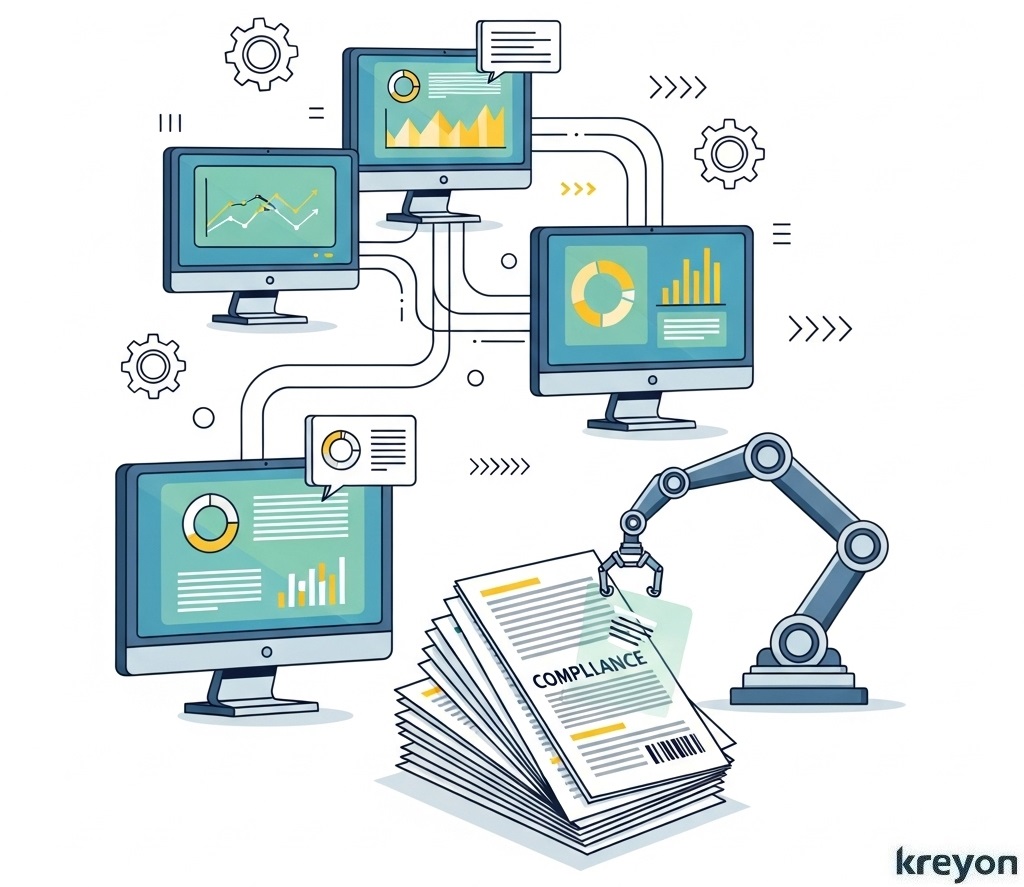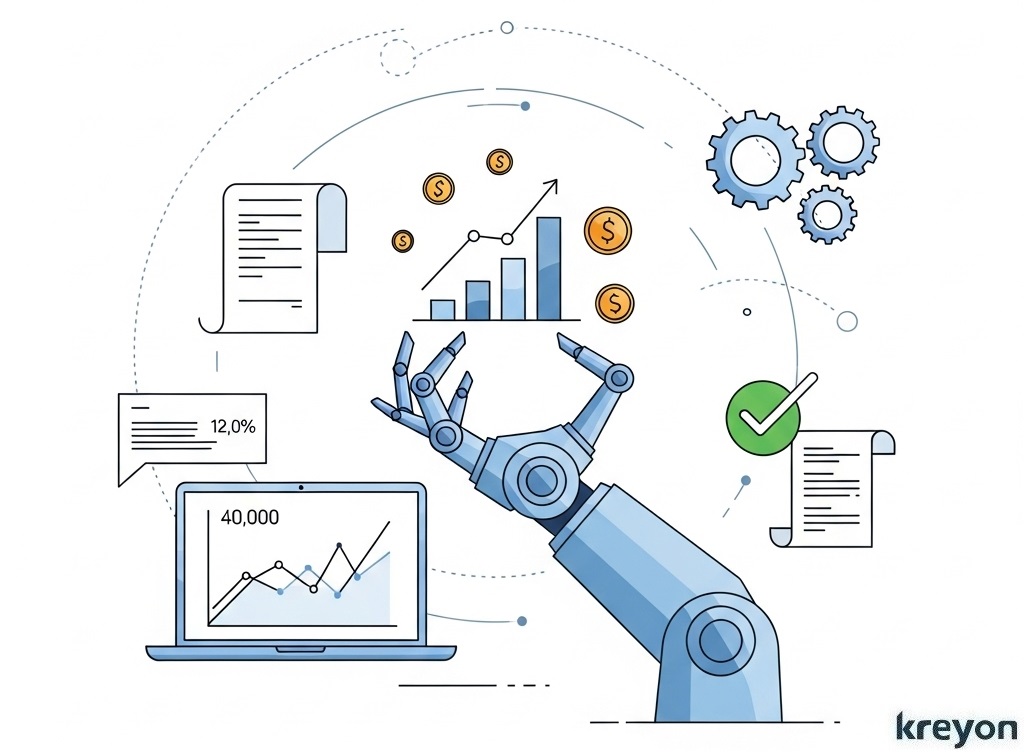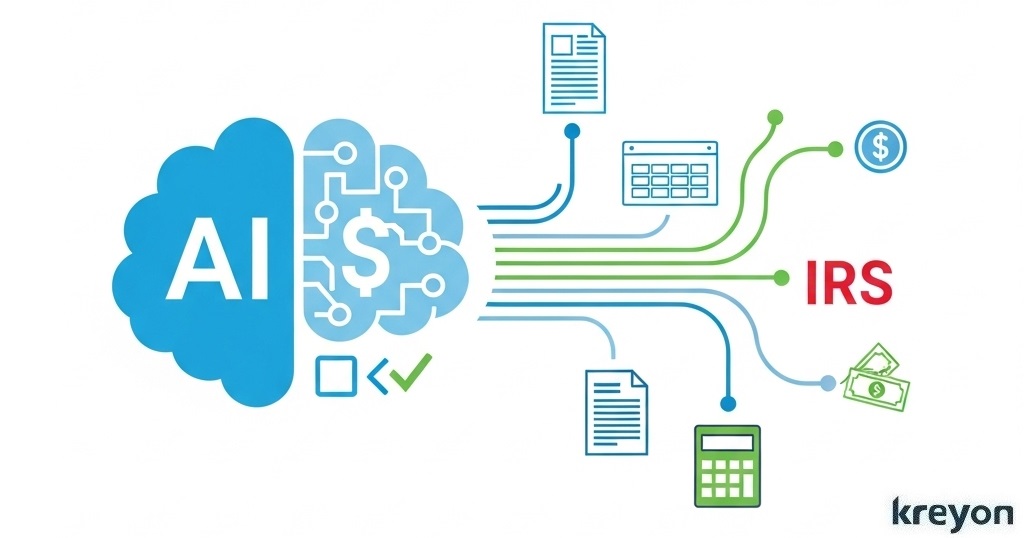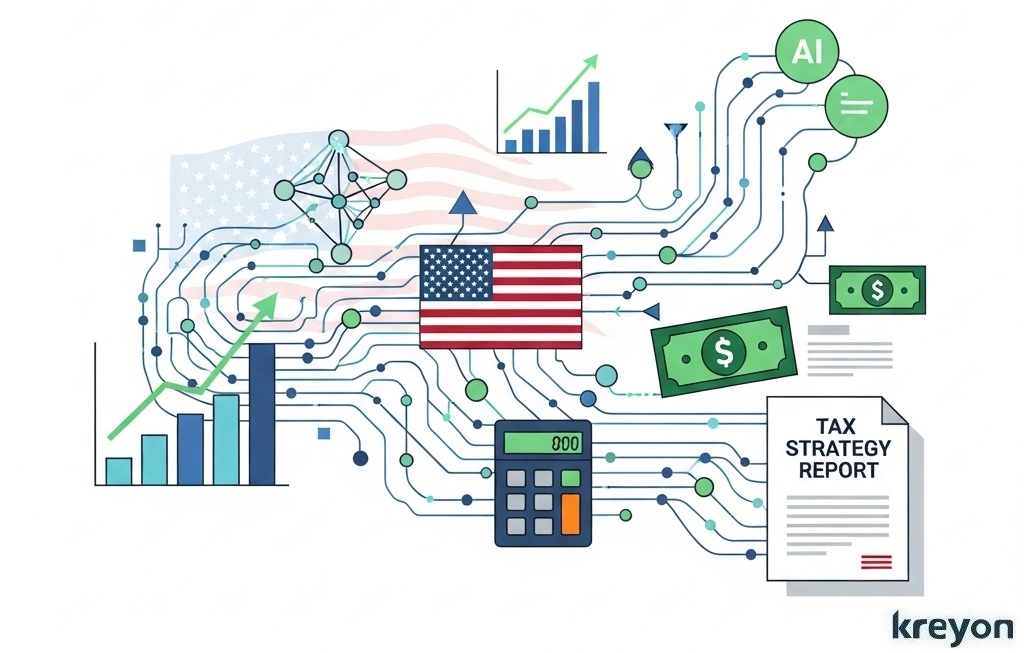Leveraging AI for Tax Planning and Compliance Reporting in US Companies

AI for tax planning and compliance reporting in U.S. companies is become indispensable as organizations face growing regulatory complexity, data volume, and the demand for real-time financial accuracy.
Tax planning & compliance reporting is a critical yet complex function for U.S. companies, navigating an intricate web of IRS regulations. Ranging from the Tax Cuts and Jobs Act (TCJA) of 2017 to Section 199A deductions for Qualified Business Income (QBI).
Noncompliance carries significant costs: in fiscal year 2023, the IRS collected $31.9 billion in recommended additional taxes from 582,944 audits.
Meanwhile, traditional tax planning methods, reliant on manual processes, static spreadsheets & outdated softwares, struggle to keep pace with evolving regulations and increasing transaction volumes.
AI is revolutionizing this landscape, enabling companies to optimize tax strategies, ensure compliance, and drive strategic value. This article explores how AI transforms tax planning for U.S. businesses, offering a roadmap for leaders to leverage its potential.
The Tax Planning Imperative

Effective tax planning minimizes liabilities, maximizes deductions, and ensures IRS compliance while aligning with business objectives.
U.S. companies face challenges like calculating quarterly estimated taxes, claiming R&D tax credits, and adhering to Section 199A rules, which allow eligible pass-through entities to deduct up to 20% of QBI but expire in 2025 unless extended.
Noncompliance is costly: the IRS assessed $17.8 billion in additional taxes for untimely filed returns in 2024.
Small and midsize enterprises (SMEs), often lacking dedicated tax teams, are particularly vulnerable, with 71% of businesses reporting tax compliance challenges, per a 2024 Tax Foundation report.
Manual tax planning is error-prone, with 25% of filings containing mistakes due to manual data entry, according to industry estimates.
Complex IRS rules, such as determining QBI deduction eligibility or managing transfer pricing for multinational operations, demand real-time adaptability that legacy systems cannot provide.
AI offers a solution, automating routine tasks, enhancing accuracy, and delivering predictive insights to optimize tax outcomes.
AI’s Role in Tax Planning

AI’s ability to process vast datasets, adapt to regulatory changes, and provide predictive analytics makes it a transformative tool for tax planning.
By integrating with enterprise resource planning (ERP) systems and leveraging machine learning, natural language processing (NLP), and predictive analytics, AI ensures compliance and maximizes tax efficiency. Below are key applications of AI in tax planning.
1. Automated Compliance and Real-Time Monitoring
AI platforms like Avalara and Vertex automate IRS compliance by interpreting tax codes and applying them to transactions in real time. Machine learning algorithms categorize expenses, calculate deductions, and flag issues, such as misclassified independent contractors under IRS Form 1099 rules with high accuracy.
For example, AI ensures proper application of Section 179 deductions for equipment purchases, reducing audit triggers. In 2024, the IRS closed 505,514 audits, yielding $29 billion in additional taxes, underscoring the need for precision.
AI’s real-time monitoring detects discrepancies as transactions occur, preventing errors that lead to penalties. For instance, AI can identify improper expense categorizations, reducing audit risks.
In 2024, the IRS collected $77.6 billion in unpaid assessments, highlighting the importance of proactive compliance. By integrating with IRS e-filing systems, AI ensures timely submissions, avoiding the $3.2 billion collected from delinquent returns in 2024.
2. Predictive Analytics for Tax Optimization
AI’s predictive capabilities enable proactive tax planning. By analyzing historical financial data, market trends, and regulatory changes, AI forecasts tax liabilities with high precision.
For example, AI can predict quarterly tax obligations under IRS Section 6655, helping companies avoid underpayment penalties. In 2024, the IRS’s Automated Underreporter Program closed 1.2 million cases, which resulted in $7.7 billion in additional assessments, emphasizing the need for accurate forecasting.
AI also supports scenario planning, simulating the tax impact of decisions like relocating operations or claiming R&D credits.
For instance, a tech firm used AI to model the tax benefits of Opportunity Zone investments, optimizing its strategy while ensuring compliance. Such tools help CFOs reduce effective tax rates, with 60% of companies using AI-driven forecasting reporting improved tax efficiency, per industry studies.
3. Enhanced Deduction and Credit Identification
Identifying eligible deductions and credits is central to tax planning, yet manual processes often miss opportunities. AI tools for finance and accounting use NLP to analyze financial documents and pinpoint tax breaks, such as R&D credits under IRS Section 41 or QBI deductions under Section 199A.
The QBI deduction, critical for 98% of farms and pass-through entities, saved farmers over $2 billion in taxes in 2024 but faces expiration in 2025. AI ensures accurate calculations, especially for complex rules like QBI phase-out thresholds ($394,600 for joint filers in 2025).
For multinational firms, AI simplifies transfer pricing compliance, ensuring arm’s-length transactions align with IRS guidelines. This reduces audit risks, particularly as the IRS plans to increase scrutiny of large partnerships in 2025.
4. Fraud Detection and Risk Mitigation
Tax-related fraud, such as inflated deductions, costs businesses billions annually. AI’s anomaly detection identifies irregularities in real time, such as unusual expense claims or payroll tax discrepancies.
In 2023, the IRS’s focus on high-income earners and partnerships revealed a 75% noncompliance rate in virtual currency transactions, underscoring the need for robust detection. AI reduces audit risks by cross-referencing transactions against IRS benchmarks, cutting potential penalties, which totaled $17.8 billion in 2024 for untimely filings.
Implementing AI in Tax Planning: A Strategic Approach

Adopting AI for tax planning requires a structured approach to maximize benefits and mitigate risks. Here’s a roadmap for U.S. companies:
1. Identify Pain Points: Assess current processes to pinpoint inefficiencies, such as manual data entry or missed deductions. Focus on high-risk areas like QBI compliance or transfer pricing.
2. Select Tailored AI Solutions: Choose platforms compatible for your needs, for e.g. integration with ERP systems (e.g., SAP, Oracle) & IRS compliance, with real-time regulatory updates.
3. Train Teams and Systems: Equip finance teams with AI literacy to interpret outputs. Customize AI models with company-specific data, ensuring compliance with IRS Publication 1075 for data security.
4. Integrate Oversight Mechanisms: Combine AI with human expertise to validate outputs, especially for complex rules like Section 199A phase-outs.
5. Monitor Regulatory Changes: Partner with AI vendors offering automatic updates for IRS rule changes, such as adjustments to the 2025 standard deduction ($15,000 for single filers).
Challenges and Considerations
AI adoption has challenges. Implementation costs range from $50,000 to $600,000, depending on company size, per industry estimates. Data security is critical, as tax data requires compliance with IRS Publication 1075 and SOC 2 standards.
Overreliance on AI without human oversight risks errors, particularly if algorithms misinterpret nuanced IRS rules. Ethical concerns, such as biased algorithms, necessitate regular audits to ensure fairness
The Future of AI in Tax Planning
As AI evolves, its impact on tax planning will grow. Generative AI could automate complex tax form preparation, while blockchain-integrated AI may create tamper-proof audit trails.
By 2030, 80% of U.S. companies are projected to use AI for 60% of tax planning tasks, per industry forecasts. Early adopters will reduce tax liabilities by up to 25% and reallocate resources to strategic growth.
Conclusion
AI is transforming tax planning from a compliance burden into a strategic asset for U.S. companies. By automating compliance, forecasting liabilities, identifying deductions, and mitigating risks, AI ensures IRS compliance while optimizing tax outcomes.
Leaders who embrace AI now will navigate regulatory complexities with ease and position their organizations for financial resilience. In a landscape where precision is the norm, AI-driven tax planning is essential for the modern enterprise.
Kreyon Systems offers an innovative, AI-powered platform for financial automation transforming tax functions. It brings intelligence, efficiency, & easy compliance reporting. For queries, please contact us.
